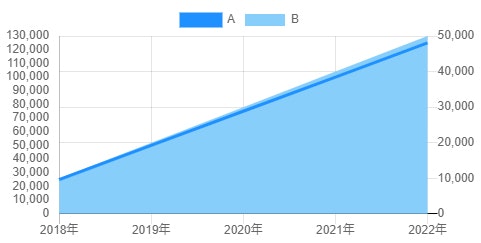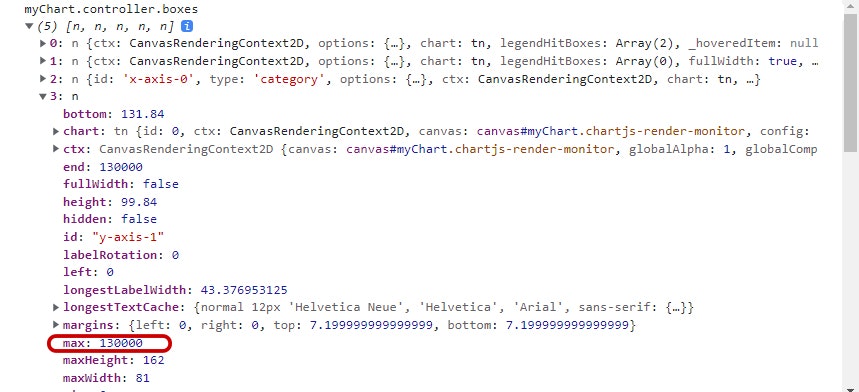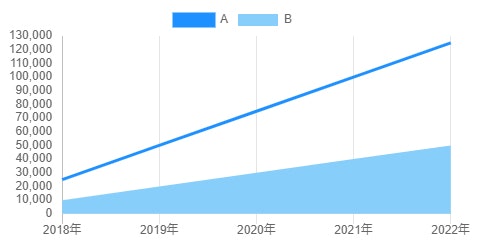js内で完結する場合は今回のような対応は必要ないと思いますが、
データ自体は別から持ってきて、目盛りのmax値も自動更新にしたい且つmax値を揃えたい場合に使いました。
↓最大値を何も設定せずに普通に作ったグラフ。
Aの目盛りの最大値が130,000、Bの目盛りの最大値が50,000となっています。

現時点でのコードは下記になります。
const ctx = document.getElementById('myChart');
let myChart = new Chart(ctx, {
type: 'line',
data: {
labels: ['2018年', '2019年', '2020年', '2021年', '2022年'],
datasets: [{
label: 'A',
tension: 0,
fill: false,
data: [25000, 50000, 75000, 100000, 125000],
yAxisID: 'y-axis-1',
borderColor: '#1E90FF'
}, {
label: 'B',
tension: 0,
data: [10000, 20000, 30000, 40000, 50000],
yAxisID: 'y-axis-2',
backgroundColor: '#87CEFA',
borderColor: 'transparent'
}]
},
options: {
tooltips: {
mode: 'nearest',
intersect: false,
},
responsive: true,
elements: {
point:{
radius: 0
}
},
scales: {
yAxes: [{
id: 'y-axis-1',
type: 'linear',
position: 'left',
ticks: {
min: 0,
stepSize: 10000,
callback: function(val){
return val.toString().replace(/\B(?=(\d{3})+(?!\d))/g, ',');
}
},
gridLines: {
display: false,
}
}, {
id: 'y-axis-2',
type: 'linear',
position: 'right',
ticks: {
min: 0,
stepSize: 10000,
callback: function(val){
return val.toString().replace(/\B(?=(\d{3})+(?!\d))/g, ',');
}
},
gridLines: {
zeroLineColor: '#000',
drawBorder: false,
}
}]
}
}
});
Aの方が目盛りの最大値が大きいので、今回はBをAに合わせていきます。
まずは、Aの目盛りの最大値を取得します。
const yAxis1Index = myChart.controller.boxes.findIndex((u) => u.id === 'y-axis-1'); // 3
const yAxis1Max = myChart.controller.boxes[yAxis1Index].max; // 130000
myChart.controller.boxesで取得できるもの↓

下記の記述を追加する。
const yAxis2Index = myChart.options.scales.yAxes.findIndex((u) => u.id === 'y-axis-2');
myChart.options.scales.yAxes[yAxis2Index] = {
ticks: {
display: false, // 目盛りの値が重複してしまうので非表示にする
max: yAxis1Max
},
gridLines: {
display: false,
}
};
myChart.update(); // グラフを更新

